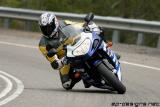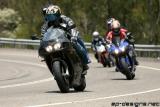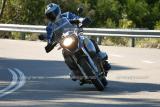Single vehicle crashes accounted for 39% of all motorcycle crashes in NSW and 39% of all fatal motorcycle crashes. This is a higher rate of single vehicle crashes compared to 23% of car crashes.
Pillions are included in fatals and serious injuries.
This is the EFFECT of various causes. We inspect statistics and this shows us where to look to find the CAUSE. (For lots more on statistics, click here: “Motorcycle Safety“)
Three basic factors emerge.
All of these are avoidable with a little forethought. A good rider will manage a risk, but needs to know what the risk is.
Lets deal with these.

A good rider who has entered a curve at the correct speed, is balanced and correctly positioned can ride over some really bad surfaces with no real problems. Riders with low skills or poor judgement will always have trouble AND usually don’t know WHEN to slow down enough to have a good look before entering the curve.
If you see a curve or corner that needs engineering attention, REPORT IT, you may save a less skilled rider from falling.
The road is not the racetrack and will never be perfect. There are no flag marshalls to tell you what is around the curve.
On day rides, have a good breakfast, a light lunch, plenty of water to drink, avoid alcohol. If you had a big night out, make it a short trip for the day. Watch out for when the coffee high suddenly “drops” you into a loss of concentration state. Take plenty of breaks on the return leg of the day ride and pay particular attention when re-entering suburban traffic. Big groups need to be aware that not all have long distance riding fitness. See the “Group Riding” brochures.
There is one thing above all else that binds riders of all ages, racial background, politics, religion, gender, or economic background and that is we all know we are an above average rider.
Ever made an error?
No, not me! I’m a good rider!
How do you know?
When someone says “stay inside your envelope” do you have any idea of what that is? In essence, it is observation, assessment, decision, proper placement and the skills to actually carry it out. i.e. being able to react and knowing WHEN and having the practiced skill to be able to do it. – making a good judgement call. It’s a mental skill to be able to do this.
A good rider shows judgement AND skill.

Don’t take on more than you can handle.
The road is not a racetrack.
Don’t get sucked in.
No podium
No prize
No point
You are the CAUSE. How you ride is the effect.

Look to the top of this page again. See the statistics?
That’s pretty average. It sure ain’t above average.
So WHO is letting down the team? Is it you?
Do you really want to know, or just blame the other riders?
Want to try an exercise to see how you rate yourself?
2024-04-12 05:09
This content isn't available at the moment
When this happens, it's usually because the owner only shared it with a small group of people, changed who can see it, or it's been deleted.2024-04-12 04:51
Contact Info
Motor Cycle Council of NSW
PO Box 517
Parramatta 2124
Ph: 1300 679 622 (1300 NSW MCC)
General Enquiries
Please direct enquiries to:
MCC Email
enquiries@mccofnsw.org.au
Site Menu